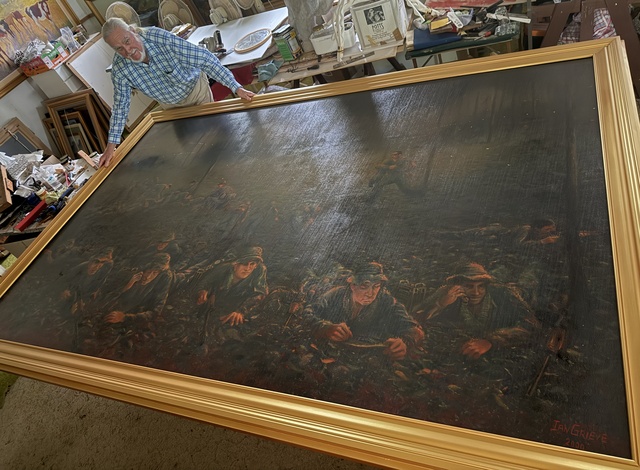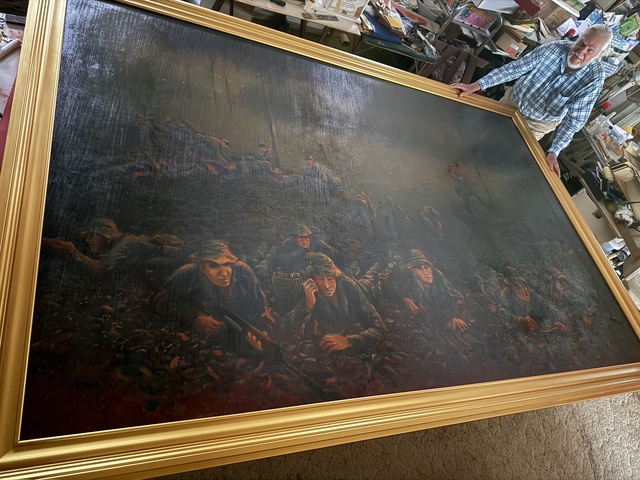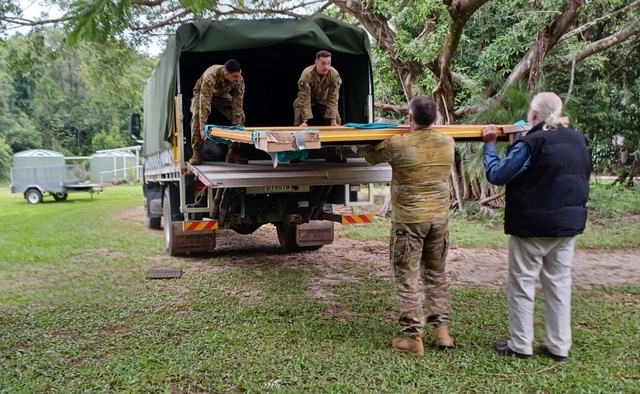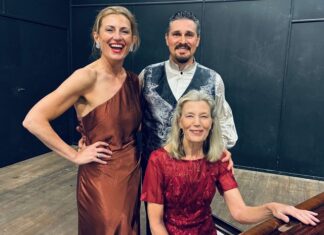
The Battle of Long Tan was one of the largest fought by Australians in the Vietnam War.
Brisbane-based Delta (D) Company, Royal Australian Regiment (6RAR), fought an ’encounter’ battle on 18 August 1966, in the Long Tan rubber plantation to defeat enemy forces that outnumbered them 10 to one.
D Company’s 105 men and three New Zealanders from 161 Battery, Royal New Zealand Artillery, fought for almost four hours against soldiers of the North Vietnamese Army.
At the end of it D Company suffered 42 casualties, including 18 dead – more than one-third of its strength – and some 245 enemy troops were killed.
It is regarded as one of the most heroic, yet at the same time costly in terms of casualties, actions by Australians during the Vietnam War.
Noosa artist Ian Grieve was captivated by the battle when he first spoke with one of those in the thick of it, Cpl Laurie Drinkwater.
That led to interviews with others in Brisbane, the Sunshine Coast and Maryborough who survived the hellish encounter.
Among them was company commander Maj Harry Smith, who provided invaluable insight into the conditions the men encountered and the roles they played in the stand against such formidable odds.
The artist embarked on a two-year mission to capture their story which resulted in a 3000mm by 1930mm acrylic and oil painting “Desperate Struggle for Survival, D Company, RAR 6th Battalion, 18th August 1966, Long Tan.’’
Now that tribute has taken the journey to the Enoggera Barracks in Brisbane to find its home in the battalion museum.
The painting, hand-framed by Ian, weighed 60kg and was carefully hand-loaded into an army truck at the Doonan studio.
Those people who have seen the original canvas believe it to be a remarkable painting, an example of excellent skill, assiduous research and painstaking attention to detail.
This painting is a highly believable account of the battle, painted with emotion and honesty.
The Enoggera Barracks is the home where it should be lodged at, Ian said.
“It’s been a long time coming but the new museum has just had a big upgrade and it will be featured. I’m looking forward to it being in its natural home.
“The characters in the painting are all depicted of how they looked at the time.’’
The painting came about in 1997 when Ian saw a photograph of a presentation at a commemorative service for the anniversary of the Battle of Long Tan.
He then read The Soldiers Story, a book by Terry Burstall who was in D Company.
“Upon reading it I knew that I had to do this painting. His book was so full of emotion and reluctant heroes … I had to capture it on canvas for the sacrifice and courage of the veterans under extreme conditions.
“As with all paintings I had to choose a ‘moment in time’ for this portrayal of the battle.
“It is set in the gloomy light of the rubber plantation, in heavy torrential rain. The eerie light, the wounded in the background at the aid station, in a slight depression, and with members of the company headquarters facing the enemy.
“There is a definite ‘haze’ to it, showing the smoke from the heavy fighting. The torrential rain, the fireflies of the enemy tracer bullets.’’
Company headquarters played a crucial role throughout the battle, maintaining the formations in a common perimeter to defend their base.
D Company employed skilful tactics and showed great tenacity and courage against overwhelming odds.
The level of detail in the painting is remarkable, testament to the artist including actual likenesses of those in the front line either from photographs or personal interviews.
“The whole battle was fought in torrential rain and visibility dropped to 50m.
“That meant the Vietnamese, who were estimated to be over 2000, didn’t see the size of the Australian group. Every time they tried to move forward they came up against small arms fire in staggered lines and that’s probably what saved the Australians.
“Harry (Smith) said that he and New Zealander Capt Morrie Stanley agreed where they were on the map, and that was critical in advising the New Zealand artillery of where they were positioned.’’
“The fighting was close contact so that 50m either way would’ve put the forward ranks in the firing line of the artillery.
“They had the benefit of very precise control of their ammunition manufacture which helped to pinpoint the accuracy.
“There was no aerial support due to the rain and low cloud.
“They called in a helicopter back at base who were told they would have faced being court marshalled if they did. Yet they went in and delivered ammunition as well as blankets because of the large number that were wounded.“
“Cpl Phil ’Doc’ Dobson never lost a man in Vietnam if they arrived at the aid station alive.’’
Terry Burstall was a horse breaker from Queensland, Ian said, and is living near Enoggera.
He had managed a plantation in Papua New Guinea after they came back from Vietnam and at one of the reunions in 1990 people said someone should write a book about this … so he went to university and did that.
“I couldn’t put the book down once I started. Most of those soldiers were 19 or 20.’’
Harry Smith, whether living at Nambour or Maryborough at the time of Ian’s interviews was very helpful and gave guidance on the composition of who was next to who.
That was condensed to depict the intensity of the battle yet maintain the integrity of the positions and the activity, such as the wounded soldier Pte Harley Webb being rescued by WO 2 Jack Kirby carrying him on his shoulders.
Radio operator Pte William ‘Yank’ Akell alone took a replacement radio out to 10 Platoon after they lost communication with company headquarters during the battle. It was how Maj Smith was able to tell them to fall back from their perilous forward position.
Included in the painting are Pte ‘Pommie’ Rencher, L/Cpl Graham Smith – signaller to Maj Harry Smith, L/Cpl Geordie Richardson, Bdr Willy Walker – Royal NZ Artillery and Cpl Thomas Henry ‘Buddy’ Lea – one of six Indigenous servicemen in the unit.
As the fighting continued, Australian reinforcements were committed to the battle. B Company was on the way. A Company was loaded into Armoured Personnel Carriers of 3 Troop, 1 Armoured Personnel Carrier Squadron, which fought its way into D Company just before 7pm, as daylight was fading.
Harry Smith and Laurie Drinkwater went to the Doonan studio to see the final painting and gave their nod of approval.
In 2016 Ian and his wife Judy Hall-Grieve joined the 50th anniversary trip back to Vietnam, visiting and walking the battle field and viewing a typical rubber plantation.
“D Company 6 RAR were the bravest blokes I have ever met,’’ Ian said, “and I consider it a privilege to have met and known some of them.’’
ABOUT THE ARTIST:
Ian Grieve studied at Alexander Mackie College, now Sydney Fine Art College gaining a Diploma of Art, then went to Sydney Teachers College, Sydney University gaining a Post Graduate Diploma Art Education.
Now a professional artist living at Noosa, Ian’s name can be found in WD Thorpe’s “Who’s Who” of Australian Visual Artists.
He has painted oil portraits for the Queensland Government, of former Premier Mike Ahern and Russel Cooper. These portraits are displayed in Parliament House, Brisbane.
Ian has had numerous one-man exhibitions and is represented in Japan, PR China, England, USA and Germany.
He was the first Australian to lecture at the Central Academy of Art and Design in Beijing, PR China, and has represented Australia as a finalist in the World Ceramic competition, Japan.
During the year 2008, Ian Grieve and his wife, went to the remote Indigenous community of Ali Curung in the Northern Territory to help Indigenous people set up Indigenous-owned retail businesses in art and tourism.
They lived on community for over 11 years before retiring in 2019 to their small acreage residence at Doonan.








